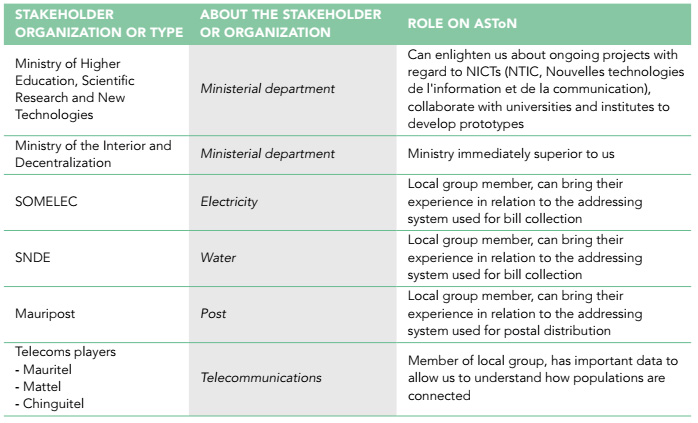Adressing the city
Focus area for ASToN
The theme chosen by Nouakchott is Addressing the city
Problem outline
The absence of an addressing system which is widely adopted by the population has a big impact on the daily functioning and development of the city. On the civic side, daily activities are hampered by the fact that people do not have a common understanding of address. At the moment people are orientating themselves using major landmarks and more recently with GPS.
All the municipalities in Nouakchott were addressed in 2001. It went for physical addressing using the method called “metric addressing” which refers to the method of numbering the doors corresponding to the number of metres from the start of the street. During implementation of this addressing, complications appeared such as “gazras”, which cannot be addressed because they are illegal, or the naming of streets that cross several municipalities.
In addition to physical addressing, this project also had a component which related to a tax investigation, a communications component and an organizational component which resulted in the creation of an “addressing unit” within the Region’s resources directorate. This structure aimed to control the maintenance of addressing, the supply of data to tax management and the collection of information necessary for improving municipal management. Nowadays this cell has lost its effectiveness and efficiency and has adopted obsolete organizational forms and computer software. Therefore, it is essential to list and review all the procedures still in place in order to ensure the sustainability of the tax addressing system in Nouakchott.
For local authorities, addressing can open up a significant number of opportunities and benefits. This would improve the mobilization of local financial resources, as well as the quality of urban services.
The objective of this project is to set up a modern addressing system, integrating a new approach based on the use of new technologies, with the involvement of the population.
Finding: the starting point for solving these problems
The following observations define Nouakchott’s starting point when trying to solve the addressing problem. Based on the research carried out during phase 1, they express the strengths and weaknesses to be taken into account, which are often interlinked.
As the city continues to grow at a steady pace, the need for a coherent and comprehensive addressing system is becoming more and more urgent
From a demographic point of view the city is in perpetual growth which is corroborated by a very high degree of urban sprawl. This assumes that any addressing system should take into account not only the current state of affairs but also future needs.
Address systems already exist, but they are inconsistent and poorly understood by the general public
Large utility companies, such as electricity and telecoms providers, already use their own addressing system. Private players and start-ups have also developed addressing solutions. The start-up Sedhini, for example, generates a 3-digit code for each home. But these systems continue to not be widely adopted.
“ Change takes a long time here.”
The adoption of addresses is limited by the mentality of citizens as much as by the problems with the systems that exist themselves
Resistance to their adoption is attributed by some to the citizens’ resistance to change. Others attribute it to the complexity of existing addressing sys- tems, which are made up of long series of numbers and letters. In addition, there has been little communication and coordinated action on the subject.
“No one knows their address.”
Insufficient research has been done to understand the views of citizens
There is the opportunity to do workshops to understand what would motivate citizens to use an addressing system, and what they need from an addressing system. Local authorities have some experience of engaging with the public by organizing workshops, but they would benefit from more tools to involve citizens in the development of a solution.
Project managers have a good understanding of the local authority’s strengths and needs in the project
The local authority has a grand vision of addressing which brings more development for the city. It also recognizes the need to work with other people in the public and private sectors to achieve these big ambitions.
“They [the government] have a limited understanding of Agile and lack the mechanisms to effectively support start- ups.”
There is a negative perception of collaboration with the government, which could pose a risk to the project
In the private sector, the prevailing impression is that the government lacks the understanding of what is necessary to work with them, especially start-ups.
Next steps
The Nouakchott region does not have a digital strategy to manage digital work. The ambition is to use its involvement in the ASToN network to coordinate its digital projects and develop a digital strategy.
Stakeholders involved in the local ASToN group

Participating in the ASToN network




